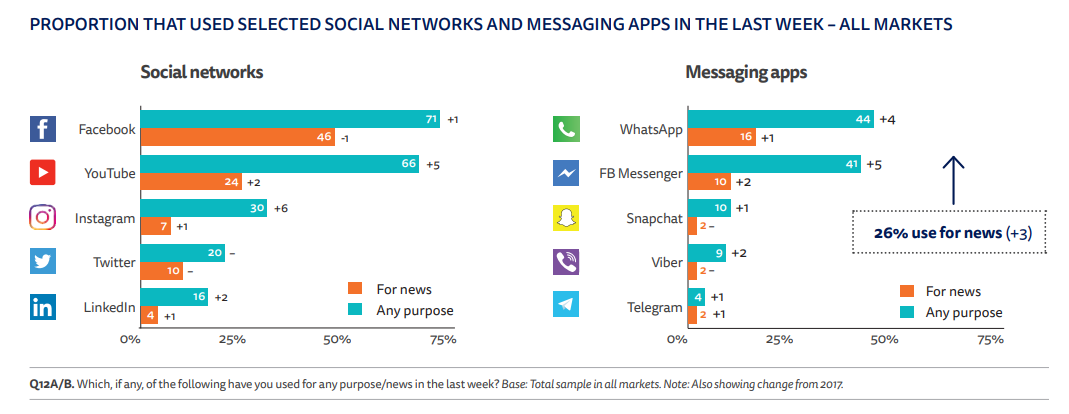Each year, the Reuters Institute Digital News Report (DNR) sheds light on the most recent trends in the news industry and news consumption – as Director of Research Rasmus Kleis Nielsen remarked with the launch of the report, “Journalism exists in the context of its audience.” Recognizing this, it is critical to understand where and how audiences access news media. According to the DNR, one answer to that is steadily less through social media – ie Facebook – and more through private messaging.
Though the extensive survey and analysis of the DNR brings more of this finding to bear, one has to hope this isn’t too large of a newsflash for many. And not only because a recent CIMA report delved into precisely this trend. That report emphasized the key role of “dark social” messaging for news, particularly in repressive countries. But as the DNR confirmed, the trend is spreading across the globe. The use of Facebook and social media has largely flatlined in the past year, and in fact dropped for discovering, posting, and sharing news. Audiences drive this change. The platforms are certainly aware, and actively trying to reengage their declining audiences. Publishers, too, must be aware of how best to engage their audience and where readers are coming from.
The decline in news access through social media is undoubtedly due, in part, to changing algorithms that deemphasize news in favor of “community” posts from friends and family. Yet, this is only one piece of the trend captured in the DNR survey, which was conducted prior to Facebook’s most recent algorithm changes. Instead, some users have moved away from platforms like Facebook and Twitter simply because the new alternatives are more engaging, while private messaging offers an escape from increasingly politicized comment threads and the prying eyes of grandparents and governments. What might this growing trend mean for the audience, the platforms, and the publishers?
The Audience
- Messenger applications like WhatsApp broadly appeal to users as a more private, secure platform (especially following Cambridge Analytica revelations). And this is true – but not all messengers are created equal. Before you throw caution to the wind in seemingly closed discussions, be sure you know just how private it is.
- While closed messaging encourages more honest discussions, it also intrinsically suggests a more tight-knit group than the typical social media community. Inevitably, those closed groups may simultaneously add to the “echo chamber” of an increasingly polarized environment.
- That same context encourages trust in shared news and articles, boosting clicks for news websites through this “dark social” sharing. Yet again, there is a flipside: disinformation and false rumors, or “fake news,” can spread quickly through such messenger groups – and thanks to their security, go largely unchecked. The onus is largely left to the audience not just to check sources, but, even better, to follow up with fact-checkers like FactCheck.org or Verificado.
The Platforms
- Wary of its declining user base and negative publicity of “fake news” and disinformation on its platform, Facebook has moved beyond continuous updates to a new algorithm input based on user-generated “trusted” outlets. As others have stressed, if this change relies upon the frequency of users identifying trustworthy sites, it could mean good news for major brands like the New York Times – but very bad news for smaller, independent outlets with smaller audiences.
- A close look at various trust initiatives now in operation shows consistent involvement from major platforms and tech companies, particularly Google, Facebook, and Microsoft. In part, project organizers, civil society actors, and others have actively engaged those that could enact change in their platforms. But more than that, the platforms themselves are equally eager (one observer dubbed them “desperate”) to cede their unwanted responsibilities that come as “gatekeepers” of news media.
- “What we have lacked as an industry,” remarked Melissa Bell at the launch of the DNR, “is not recognizing the value of our product.” Independent media has seen limited returns on investment in social media, and according to the DNR survey, audiences frequently aren’t even aware that outlets struggle to find monetary gains online. As platforms watch their users, and in turn publishers, move to alternatives, perhaps they will better see the need to improve their relationship with both.
The Publishers
- As of last fall, data from the analytics firm Chartbeat found that audiences access news pages most through a direct click on the site, then from search, “dark social” sharing and messaging, and social media, in that order. Given that, energy may be better spent on improving the homepage and user experience first and foremost, rather than focusing all energies on battling the black box of Facebook algorithms.
- Technology allows engaging with the audience more than ever before, and publishers around the world are already experimenting with opportunities for reaching a new audience, or reaching the same audience more interactively, through messaging like WhatsApp groups, Telegram channels, and more. This not only builds brands, but also leads users back to that engaging homepage experience and, if not becoming a loyal subscriber, considering a donation, one method of support that has been on the rise.
- With the many analytics tools now at hand, publishers are increasingly told to lean into their audience data for strategic planning, outreach, or perhaps reporting back to an owner or donor. Knowing where the audience is coming from is integral – but so to is knowing what the data may be missing, or misrepresenting. WhatsApp shares are not measurable, though may drive clicks to your website; skimming by a headline on Facebook also isn’t measurable, though may inspire a search for related news. In the push for numbers-driven strategies, a qualitative understanding of where the audience is coming from, and where it may be going, remains key. As Nielsen said, “Journalism exists in the context of its audience.”
Kate Musgrave is the Assistant Research and Outreach Officer at the Center for International Media Assistance. Find her on Twitter at @kate_musgrave.



Comments (0)